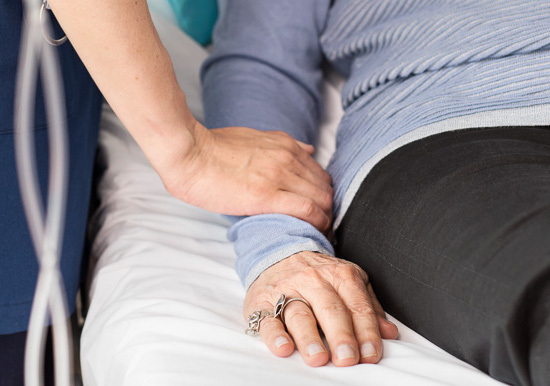The temporary technical problem in the data network connections
A temporary technical problem occurred in the data network connections of Docrates Cancer Center. We apologise for any delays caused...
Read moreMon–Fri 8–16

Lung cancer starts when cells in the bronchus or the actual lung tissue turn malignant.
Although the incidence of lung cancer has decreased in Finland, it is still one of the leading causes of cancer death among Finns. In Finnish men, only prostate cancer is a more common malignancy. Less than one third of new cases are diagnosed in women, but the percentage of women is rapidly increasing along with the increase in women smokers.
There are two main types of lung cancer: non-small cell lung carcinoma and small cell lung carcinoma. About 85% of all lung cancers are non-small cell carcinomas, and the remaining 15% are small cell lung carcinomas. There are specific treatments for each type.
Smoking is the best known and most studied cause of lung cancer: it causes 90% of all cases of lung cancer. Passive smoking (exposure to cigarette smoke produced by other people) also increases the risk. There are many factors in our working and living environments that increase the risk of lung cancer, such as arsenic, nickel and chromium compounds, radon and asbestos.
The symptoms of an early stage lung cancer are often very few and mild; distinct symptoms appear at a more advanced stage. Typical symptoms of lung cancer include:
Sometimes the illness is not detected until it spreads to lymph nodes in the neck and these become swollen.
A chest x-ray examination is usually the most important initial examination when lung cancer is suspected. If sputum can be collected from the patient, it can be analysed for cancer cells. Sputum specimens are collected in a container and analysed under a microscope. However, this method is not very reliable. It is also possible to perform fine needle aspiration or core needle biopsies on the tumor in order to establish a diagnosis. This is done by bronchoscopy: the pharynx is anaesthetised, and the bronchoscope is led through the mouth and trachea into the lungs. Biopsy samples are then collected.
If a diagnosis cannot be established in this way, a tissue sample of the tumor can be collected through the skin using a thin needle. The location of the tumor in the lungs dictates whether this is possible. The needle is targeted to the precise location under ultrasound or CT guidance. The examination can feel unpleasant for the patient. Fortunately, it does not take very long. The tissue sample is analysed under a microscope for signs of cancer cells.
In order to ensure correct planning of treatment, it is important to determine whether the cancer is a non-small cell or small cell carcinoma. Staging is usually performed by a CT scan of the lungs. The scan helps to assess whether the tumor has spread to mediastinal lymph nodes between the lungs or to other parts of the lungs.
There are several possible treatments for lung cancer: surgery, radiotherapy, chemotherapy and other targeted pharmacological therapies. In addition to the cell type, the choice of treatment depends on the stage of the cancer, the patient’s age and gender and the presence of possible general symptoms (weight loss) before treatment.
Surgery is the primary treatment for non-small cell lung cancer. It is the only available curative treatment for lung cancer. The operation is demanding, and it is only possible if the patient’s physical condition is good enough and the cancer has been confirmed to be a non-small cell carcinoma and is localised. In small cell lung carcinomas, surgery is possible only in the event that the tumor is restricted to a sufficiently small area. Chemotherapy is the most important treatment for small cell lung cancers. Chemoradiotherapy (a combination of chemotherapy and radiotherapy) is effective in both types of lung cancer; it can hold back the progress of the disease, improve patients’ quality of life and prolong survival.
A temporary technical problem occurred in the data network connections of Docrates Cancer Center. We apologise for any delays caused...
Read more
Hannu Nurmio was aware that prostate cancer is the most common cancer in older men. However, after the diagnosis was confirmed,...

Early detection of colorectal cancer is crucial for successful treatment. If diagnosed early, up to 90% of cancers can be...

Docrates Cancer Center is the first service provider in the Nordic region to launch a new experimental alpha radiation treatment...
Contact us!
Mon-Thu 8:00-18:00, Fri 8:00-16:00
